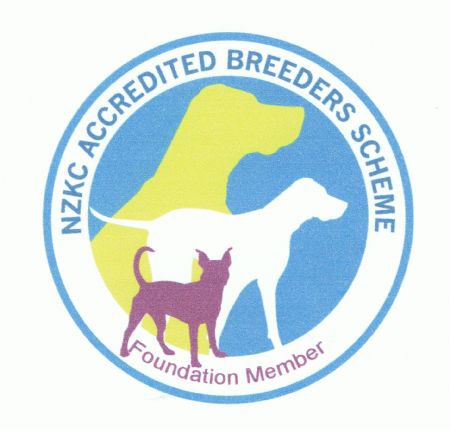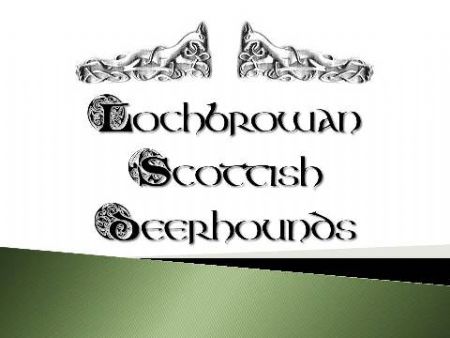|
A Brief introduction to the Scottish Deerhound
Having a Scottish deerhound WILL change your life forever.

Jag's favourite sleeping place was an enormous pink unicorn!
They are impossible to ignore, whether they are on your bed, sofa or hogging the fire, digging holes in the flower borders, or hugging you when your sad. The sofa was invented specifically for the deerhound - however comfort is paramount so three seaters are preferred to smaller sizes. Any chance will see a deerhound sneak onto a bed for a quick snooze. If this occurs at night, you may not even feel this happen and wake to find your pillow has mysteriously transformed into a grey hairy beasty! Deerhounds also love to help with the gardening. Flowers are picked, bulbs dug up and huge holes appear rather quickly, especially in newly turned soil. I have found that the holes are not just pretty they are practical. When reversed into, they keep a deerhound cosy in winter or cool in summer.

They have an amazing sense of humour, and are undoubtedly a unique breed. Not only are they a true sight hound, but also a true, loyal, loving companion and family pet. They come into their own as a house dog: what else can you expect from a dog owned and bred by nobility who lived in the castles of Scotland. Their noble look makes them irrestistible to look at - whether they are lounging in repose or fluidly bounding across a meadow or moor. Pauls says that they are "Flat out dogs" - either flat out asleep or flat out galloping around.
I have found them to be easy to train but this does involve giving them options - they will invariably take the easy one! They can easily teach themselves new tricks like opening doors, but to be honest too much thought just interrupts the sleep processes.
This breed comes with extensive history: both fact and fiction, and this only adds to their mystery. There have been many books written about their past, anecdotes, pedigrees and breed standards. I highly recommend "Living with Deerhounds" by Kay Barrett of Stranwith deerhounds, as a very true description of living with deerhounds! Please do not hesitate to contact us if you want more information about this amazing breed.
I have attached the following article by Michelle Welton about Deerhounds.
Scottish Deerhound Temperament
What's Good About 'Em,
What's Bad About 'Em
By Michele Welton.
Copyright © 2000-2014
Like all sighthounds, the quiet, dignified Scottish Deerhound doesn't behave like most dog breeds you may be used to, like a Golden Retriever or German Shepherd. For example, a Scottish Deerhound is unlikely to fetch a ball or play tug-of-war or protect your family.
Oh, certainly, Scottish Deerhound puppies and adolescents are as active, awkward, and mischievous as any other breed. But adults tend to be calm, graceful, and undemanding. They learn house rules well and spend much of their time sprawled blissfully on the softest sofa. Generally sighthounds do not like to be mauled or clutched at; they tend to move away from too much overt physicalness.
It is outdoors where Scottish Deerhounds have such special needs. They require space for the long strides of their floating lope (described as "poetry in motion") and their powerful, driving gallop. But it must be a safe, enclosed area, else they will be out of sight in seconds and end up dead on the road. It has happened time and time again with sighthounds.
Because of his great size, strength, and speed, the Scottish Deerhound does require early socialization, but he is almost unfailingly polite with strangers. This is not a guard dog, sometimes not even a watchdog -- some easygoing individuals will remain comatose when the doorbell rings.
Scottish Deerhounds are amiable with other dogs, but are serious chasers of anything that runs, including cats and tiny dogs.
Though mildly stubborn and independent, this is also a sweet and sensitive dog. He is willing to respond (albeit in a slow, casual way, as though humoring you) to cheerful training that includes consistent guidance, verbal praise, and food rewards.
- Is tall, slender, and elegant, yet very powerful -- a racy athlete
- Has a short ragged coat
- Is extremely athletic and graceful -- can run swiftly and jump great heights
- Carries himself in a calm, dignified manner and is mannerly and undemanding (virtually inert!) in your house (adults only)
- Is polite with strangers and absolutely not a guard dog
- Is amiable with other dogs
- Doesn't bark much
A Scottish Deerhound may be right for you.
- Providing a safe enclosed area where he can gallop
- Timidity when not socialized enough
- Emotional sensitivity to stress and abrupt changes in schedule
- Strong instincts to chase other living creatures that run
- An independent "what's in it for me?" attitude toward training -- can be stubborn and strong-willed
A Scottish Deerhound may not be right for you.
If I was considering a Deerhound, I would be most concerned about...
- Providing enough space and controlled exercise. Scottish Deerhounds don't need miles of running, but they MUST have regular opportunities to vent their energy through all-out galloping a few times a week. Otherwise they will express their boredom through destructive chewing.
| Scottish Deerhounds need access to a large fenced area -- fenced because these independent dogs are likely to take off and not come back. If there is a dog club in your area, get your Scottish Deerhound involved in lure coursing (chasing a mechanized lure around a track or across an open field). This is an appropriate outlet for the full-speed galloping behaviors that are "hardwired" into his genes. |
- Providing enough socialization. Standoffish by nature, Scottish Deerhounds need extensive exposure to people and to unusual sights and sounds. Otherwise their natural caution can become shyness
- Chasing other animals. Most people do not realize just how fast and agile sighthounds are -- or how strong their instincts are to chase and seize fleeing creatures. Most Deerhounds will pursue your neighbor's cat or small dog, if given the chance. And while they will be peaceful with your own cat or small dog when indoors, if the same cat or small dog goes outside and starts to run, it becomes fair game. In today's society, the legal liabilities of owning a large hunting breed should be considered.
- The independent temperament. Like most sighthounds, Deerhounds are independent thinkers who don't particularly care about pleasing you. They can be stubborn and slow to obey. You must show them, patiently but persistently, that you mean what you say.

|


![]()

